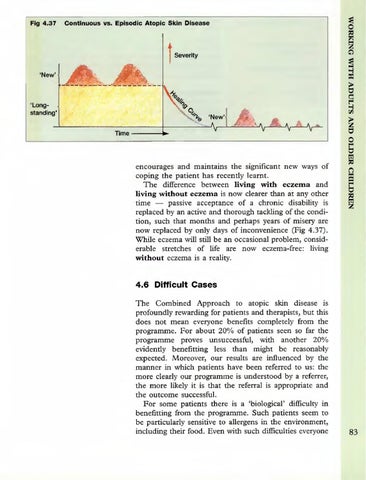Fig 4.37
Continuous vs. Episodic Atopic Skin Disease
O
z o
1 Severity 'New'
JP^raS'
.---'-' 'Longstanding'
PC
^J^^^HML.
'^HBRI-
0 G
>% v H.c<^ ^, 'New' ^^_
A V
jjk
CA
JSSli^. A
y
J&L A
'y
ft
A
V
ÂŤ.
a
n
r 0 ffl
encourages and maintains the significant new ways of coping the patient has recently learnt. The difference between living with eczema and
50
_ ffi f
passive acceptance of a chronic disability is time replaced by an active and thorough tackling of the condition, such that months and perhaps years of misery are now replaced by only days of inconvenience (Fig 4.37). While eczema will still be an occasional problem, considerable stretches of life are now eczema-free: living without eczema is a reality.
4.6 Difficult Cases The Combined Approach to atopic skin disease is profoundly rewarding for patients and therapists, but this does not mean everyone benefits completely from the programme. For about 20% of patients seen so far the programme proves unsuccessful, with another 20% evidently benefitting less than might be reasonably expected. Moreover, our results are influenced by the manner in which patients have been referred to us: the more clearly our programme is understood by a referrer, the more likely it is that the referral is appropriate and the outcome successful. For some patients there is a 'biological' difficulty in benefitting from the programme. Such patients seem to be particularly sensitive to allergens in the environment, including their food. Even with such difficulties everyone
83
